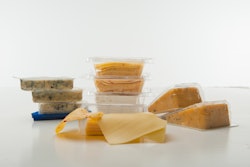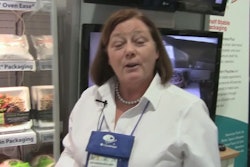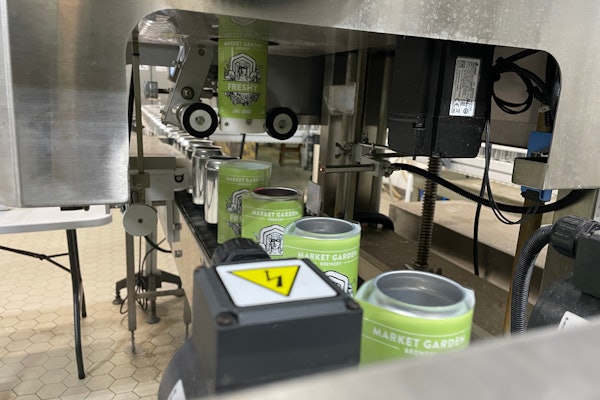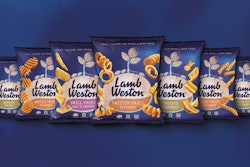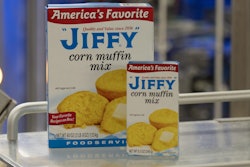These changes permit films that are lighter weight and thinner than standard blown or cast films to satisfy performance needs by generating significant increases in such properties as tensile strength, toughness, heat stability, tear initiation resistance, and barrier.
Virtually all solid-phase film orientation takes place in-line with polymer extrusion. This is due to cost and uniformity requirements for packaging applications. Solid-phase process choices include:
• Biaxial or monaxial orientation
• Flat or tubular format
• Simultaneous or sequential machine direction (MD) and cross-machine direction (CD)
Flat biaxial orientation
Flat biaxial orientation is the most prevalent film orientation process. Most of the biaxially oriented polypropylene (BOPP) and polyester (BOPET) films used in packaging are produced using the technique detailed below. Very large units, capable of producing finished film over 300 inches wide, are being installed around the world, bringing down processing costs per pound and creating plentiful supplies for the growing global flexible packaging market.
The Process: A unit commonly called a tenter frame line performs flat biaxial orientation. The term “tenter frame” refers to the CD orientation section. The process starts with a plasticating extruder feeding a first module that operates similarly to a cast film line. (For more on cast films, download the “Understanding film manufacturing techniques” PDF here.)
With flat biaxial orientation, there are multiple chill and surface finishing rolls to handle the much thicker sheet that is formed. Orientation (or “stretching”) thins the polymer web proportionally to the orientation or stretch ratios. For example, to get to a 1-mil finished film with 5:1 stretch ratios in both MD and CD, the process must start out with roughly a 25-mil web of quenched polymer.
Once the extruded sheet has been quenched and its temperature stabilized, MD stretching is accomplished by pulling the sheet using rolls rotating with progressively increasing surface speeds; stretching takes place in small gaps between successive rollers. The small gaps minimize the potential for “neck in,” which is a reduction of the width of the web during the drawing or thinning processes.
Following MD stretching, endless chains with clips grasp the edges of the moving web and carry it into a multistage hot-air oven. The first oven stage is used to equilibrate the web at the desired temperature; this is followed by CD stretching, as the two tracks carrying the chains and clips are gradually moved farther apart, making the sheet wider. Further temperature conditioning in the final oven sections provides annealing or stress relaxation for dimensional stability and cools the film prior to winding.
Applications: BOPP and BOPET are workhorse flexible packaging films, principally in laminations, where they can be used in as-oriented form, but often are vacuum-metallized, where the films themselves do not offer sufficient barrier protection. BOPP is widely used in salty, dry snack packaging, as it offers better moisture vapor barrier than BOPET. BOPP also has the lowest density of the commonly oriented packaging films, yielding more than 6% more area per pound of film at 0.70-mil thickness than 0.48-mil BOPET.
BOPET is a popular surface film in laminations where its superior stiffness, heat-resistance, and oxygen-barrier properties compared to BOPP make it a good choice for a wide variety of products. BOPET is more stable through printing and laminating processes than BOPP and is often preferred where high-quality graphics are required. It is the surface film of choice for retort pouches because of its dimensional stability through retort sterilization.
Simultaneous flat film biaxial orientation
Machines to simultaneously biaxially orient flat films had been sought for years, and workable systems are now available from machine suppliers. These machines are also equipped with clips that grasp the edges of the moving web, but in this case, prior to any solid-phase orientation. A variety of mechanical strategies are used to simultaneously move the clips farther from each other in both MD and CD.
The Process: CD separation of the tracks to achieve CD orientation is also used here, but the significant difference compared to sequential flat orientation is the need to also create MD separation of clips at the same time. The most sophisticated machines employ individual servo motors for each clip. These can be computer-controlled to create precise profiles of MD orientation while clip track CD separation takes place.
Suppliers of such machines claim that simultaneous flat orientation is capable of creating more balanced, superior mechanical performance than can be achieved in sequential orientation and also offers the ability to reach higher orientation levels. These units are also claimed to permit the orientation of complex multilayer films, including those incorporating ethylene vinyl alcohol, that are difficult or impossible to produce in sequential orientation processes due to mismatches of orientation and crystallization temperatures.
Applications: The greater mechanical complexity of these lines has limited their adoption, but as property advantages are validated in the market, and unique films introduced, we should expect to see more of these lines installed.
Simultaneous tubular film biaxial orientation
Simultaneous tubular film orientation, commonly known as the “double-bubble” process, offers a smaller scale of operation and more flexibility in changing orientation ratios than the very large-scale tenter frame lines just discussed. The main advantage of the double-bubble process—the lower scale of capital investment—is offset by lower product uniformity and process control challenges and low output per line. Some BOPP is produced on double-bubble lines, and biaxially oriented nylon/polyamide (BON or BOPA) films are produced using double bubble as well as flat biaxial orientation lines.
The Process: Simultaneous biaxial orientation is inherent in the tubular, or double-bubble, orientation process. As the name implies, the first half of the production line looks very much like a standard blown-film line, but rather than slitting the edges and separating the two sides of the collapsed tube, that tube is carefully reheated and reinflated with high air pressure, expanding the diameter while simultaneously being pulled by a collapsing nip operating at a higher lineal speed than the nip sealing the beginning of the second bubble. Film is then wound in the normal manner. Generally less annealing is accomplished in this process than in the flat orientation process, yielding films with lower temperature stability and more residual shrink.
Applications: Sausage shrink films take advantage of this shrink in the form of BOPA coextrusions with EVOH processed using the double-bubble process as one example of unique properties from this approach. BOPA is superior to BOPET and BOPP in oxygen barrier and has much better puncture-resistance; these properties can often justify its higher cost compared to the other films for demanding applications.
Monoaxial orientation
Creating deliberately unbalanced properties in the MD and CD can provide valuable and unique performance advantages tailored to specific applications. Solid-phase orientation performed solely in the MD is termed MDO and in the CD, commonly termed TDO.
Shrink-sleeve label films are created by both MDO and TDO processes, depending on the configuration of the film relative to the desired direction of shrinkage in the formed sleeve. TDO shrink sleeves are typically created using a tenter frame and oven section like that used for the TD orientation step of biaxial flat film orientation. For these films, substantial shrinkage at relatively low temperatures is desired, and minimal annealing (stress relaxation under tension) after orientation is applied.
In standalone coextrusions and lamination films, polyethylene films post-extrusion machine direction-oriented are expanding in use, as increased MD stiffness, optical properties, and barrier, as well as TD tear strength offer downgauging opportunities and a better appearance.
The Process: Easily installed add-on modules to blown-film lines permit modest MDO of films to build additional stiffness in the MD of films treated in this manner, as well as improvements in film barrier properties. The process technology for MDO is similar to that of the MD orientation step in biaxial orientation; post-quenched film is temperature-conditioned and stretched between a pair of differential speed rollers in close proximity to minimize the unsupported gap where orientation occurs.
Applications: For cereal liners, this has allowed down-
gauging and cost reductions at equivalent packaging line and product protection performance, while offset by lowered resistance to tearing in the MD. Use of tougher copolymers in blends or coextruded film layers can somewhat alleviate the tendency for “splitting” but must be balanced against the achievement of desired strength and barrier properties.
Oriented film summary
The improvement in mechanical, optical, and barrier properties of oriented films makes them compelling choices for flexible packaging structures. Of the biaxially oriented films, BOPET offers performance at low thickness, high stiffness, good heat-resistance, and a reasonable balance of oxygen and moisture vapor barrier.
BOPP offers superior moisture vapor barrier and the lowest density of the BOPET, BOPP, and BON triumvirate. BOPA provides the best oxygen barrier and exceptional toughness and puncture-resistance. Standard versions of all three films, which tend to offer good balance in mechanical properties between MD and CD, are widely sourced and specified for their unique contributions to packages.
Single-, or mono-, direction orientation yields films with more specialized, unbalanced directional properties and must be carefully considered to take advantage of these unique attributes. Orientation processes are an important part of the polymer processing arsenal to convert pellets of plastic resin into valuable packaging films.
Liked this article? Download the entire playbook here.




